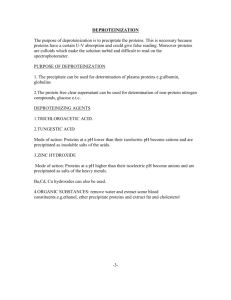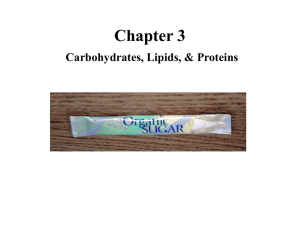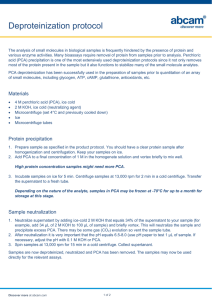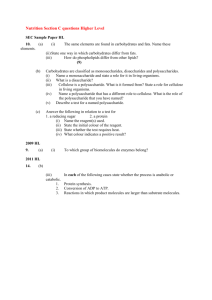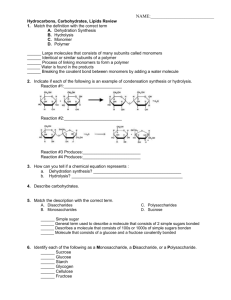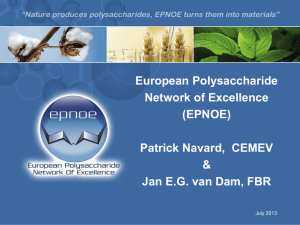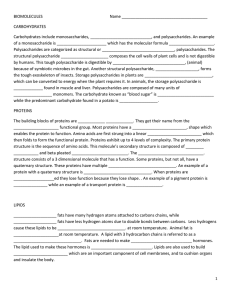Advance Journal of Food Science and Technology 11(7): 506-511, 2016 DOI:10.19026/ajfst.11.2669
advertisement
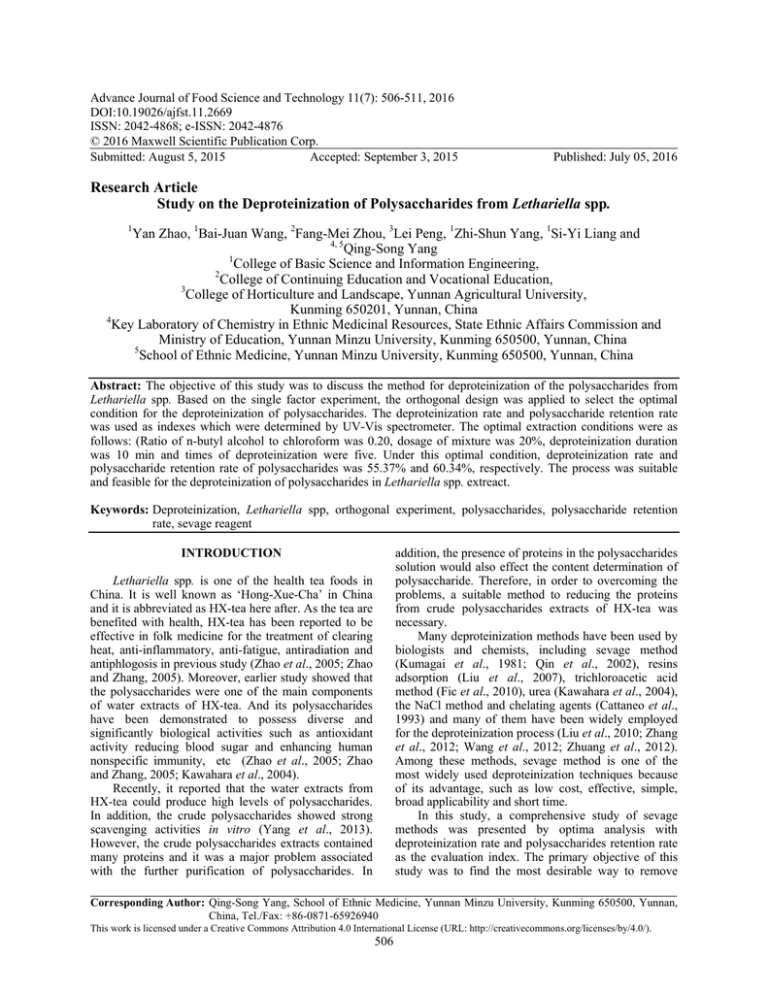
Advance Journal of Food Science and Technology 11(7): 506-511, 2016 DOI:10.19026/ajfst.11.2669 ISSN: 2042-4868; e-ISSN: 2042-4876 © 2016 Maxwell Scientific Publication Corp. Submitted: August 5, 2015 Accepted: September 3, 2015 Published: July 05, 2016 Research Article Study on the Deproteinization of Polysaccharides from Lethariella spp. 1 Yan Zhao, 1Bai-Juan Wang, 2Fang-Mei Zhou, 3Lei Peng, 1Zhi-Shun Yang, 1Si-Yi Liang and 4, 5 Qing-Song Yang 1 College of Basic Science and Information Engineering, 2 College of Continuing Education and Vocational Education, 3 College of Horticulture and Landscape, Yunnan Agricultural University, Kunming 650201, Yunnan, China 4 Key Laboratory of Chemistry in Ethnic Medicinal Resources, State Ethnic Affairs Commission and Ministry of Education, Yunnan Minzu University, Kunming 650500, Yunnan, China 5 School of Ethnic Medicine, Yunnan Minzu University, Kunming 650500, Yunnan, China Abstract: The objective of this study was to discuss the method for deproteinization of the polysaccharides from Lethariella spp. Based on the single factor experiment, the orthogonal design was applied to select the optimal condition for the deproteinization of polysaccharides. The deproteinization rate and polysaccharide retention rate was used as indexes which were determined by UV-Vis spectrometer. The optimal extraction conditions were as follows: (Ratio of n-butyl alcohol to chloroform was 0.20, dosage of mixture was 20%, deproteinization duration was 10 min and times of deproteinization were five. Under this optimal condition, deproteinization rate and polysaccharide retention rate of polysaccharides was 55.37% and 60.34%, respectively. The process was suitable and feasible for the deproteinization of polysaccharides in Lethariella spp. extreact. Keywords: Deproteinization, Lethariella spp, orthogonal experiment, polysaccharides, polysaccharide retention rate, sevage reagent addition, the presence of proteins in the polysaccharides solution would also effect the content determination of polysaccharide. Therefore, in order to overcoming the problems, a suitable method to reducing the proteins from crude polysaccharides extracts of HX-tea was necessary. Many deproteinization methods have been used by biologists and chemists, including sevage method (Kumagai et al., 1981; Qin et al., 2002), resins adsorption (Liu et al., 2007), trichloroacetic acid method (Fic et al., 2010), urea (Kawahara et al., 2004), the NaCl method and chelating agents (Cattaneo et al., 1993) and many of them have been widely employed for the deproteinization process (Liu et al., 2010; Zhang et al., 2012; Wang et al., 2012; Zhuang et al., 2012). Among these methods, sevage method is one of the most widely used deproteinization techniques because of its advantage, such as low cost, effective, simple, broad applicability and short time. In this study, a comprehensive study of sevage methods was presented by optima analysis with deproteinization rate and polysaccharides retention rate as the evaluation index. The primary objective of this study was to find the most desirable way to remove INTRODUCTION Lethariella spp. is one of the health tea foods in China. It is well known as ‘Hong-Xue-Cha’ in China and it is abbreviated as HX-tea here after. As the tea are benefited with health, HX-tea has been reported to be effective in folk medicine for the treatment of clearing heat, anti-inflammatory, anti-fatigue, antiradiation and antiphlogosis in previous study (Zhao et al., 2005; Zhao and Zhang, 2005). Moreover, earlier study showed that the polysaccharides were one of the main components of water extracts of HX-tea. And its polysaccharides have been demonstrated to possess diverse and significantly biological activities such as antioxidant activity reducing blood sugar and enhancing human nonspecific immunity, etc (Zhao et al., 2005; Zhao and Zhang, 2005; Kawahara et al., 2004). Recently, it reported that the water extracts from HX-tea could produce high levels of polysaccharides. In addition, the crude polysaccharides showed strong scavenging activities in vitro (Yang et al., 2013). However, the crude polysaccharides extracts contained many proteins and it was a major problem associated with the further purification of polysaccharides. In Corresponding Author: Qing-Song Yang, School of Ethnic Medicine, Yunnan Minzu University, Kunming 650500, Yunnan, China, Tel./Fax: +86-0871-65926940 This work is licensed under a Creative Commons Attribution 4.0 International License (URL: http://creativecommons.org/licenses/by/4.0/). 506 Adv. J. Food Sci. Technol., 11(7): 506-511, 2016 Table 1: Factors and levels of orthogonal test for deproteinization rate of HX-tea polysaccharides Factors ----------------------------------------------------------------------------------------------------------------------------------------------------------------A: Ratio of n-butyl alcohol to chloroform B: Dosage of mixture (%) C: Deproteinization duration (min) D: Times of deproteinization Levels 1 0.15 10 10 5 2 0.20 15 20 6 3 0.25 20 30 7 proteins from HX-tea water extracts. This study aimed that the sevage method deproteinization were optimized method to find the suitable condition. Based on the single factor experiment, the orthogonal design was applied to select the optimal condition for the deproteinization of polysaccharides from HX-tea extracts. The ratio of n-butyl alcohol to chloroform, dosage of mixture, deproteinization duration and times of deproteinization were studied in details. Meanwhile, an efficient deproteinization process for HX-tea polysaccharides hoped to be found that yields a solution suitable for subsequent polysaccharides analysis. polysaccharide retention rate and deproteinization rate were analyzed with UV-visible spectrophotometer using distilled water as control. Deproteinization rate was measured at 280 nm which was the strong absorption of protein with ultraviolet absorption method. And the method been selected for determining protein absorbance. Polysaccharide retention rate was measured using absorption of polysaccharide solutions at 490nm by phenol-sulfuric acid test. Then, the polysaccharide retention rate and deproteinization rate was defined. The polysaccharide retention rate was calculated by the Eq. (1): Polysaccharide retention rate (%) = (A1/A2) ×100 MATERIALS AND METHODS Materials and reagents: HX-tea was supplied by Shangri-La Shan-Yuan native products Co., Ltd. (Yunnan, China). The samples were dried and ground into power with an aperture size of 100 μm and then stored in a desiccator before experiment. Sulfuric acid, glucose, phenol, ethanol, chloroform, n-butyl alcohol and sodium hydroxide were obtained from Tianjin Fengchuan Chemicals and Reagents Co. (Tianjin, China). All used reagents were analytical grade and the solutions were prepared with deionized water. Extraction method: HX-tea powder (1.0 g) was extracted with distilled water for 2 h at 80°C and filtered (Yang et al., 2013). Then the extracts were mixed with three-time volumes of 80% (v/v) ethanolaqueous and the mixtures were stored at 4°C overnight, followed by centrifugation at 4000 r/min for 10 min and then they were dissolved in distilled water and dialyzed. The concentration of polysaccharide was measured by the phenol-sulfuric acid method using glucose as standard (Dubois et al., 1956). (1) where, A1 and A2 were the absorbance of polysaccharide solutions after and before deproteinization, respectively. The deproteinization rate was calculated by the Eq. (2): Deproteinization rate (%) = (1- A3/A4) ×100 (2) where, A3 and A4 were the absorbance of protein after and before deproteinization, respectively. RESULTS AND DISCUSSION Effect of ratio of n-butyl alcohol to chloroform: As the ratio of n-butyl alcohol to chloroform was increased from 0.15 to 0.35, in the ratio range, polysaccharide retention rate (ca. 75%) and deproteinization rate (ca. 55%) was high at the ratio of 0.20. During the different concentration treatment, the deproteinization rate reached the maximum at the ratio of 0.35, but it led to polysaccharide retention rate with a serious loss. So, the ratio of 0.20 was chosen as the best proportion for subsequent orthogonal experiment (Fig. 1). Deproteinization method: The sevage method was employed for deproteinization. Orthogonal experiments were carried out to optimize the deproteinization process. Effects of ratio of n-butyl alcohol to chloroform (0.15, 0.20, 0.25, 0.30 and 0.35), dosage of mixture (15%, 20%, 25%, 30% and 35%), deproteinization duration (10, 20, 30, 40 and 50 min) and times of deproteinization (1, 2, 3, 4 and 5) were employed as well by single factor experiment. Then, a three-level OAD with an OA 9(34) matrix was chosen (Table 1). Effect of dosage of mixture: The initial dosage of mixture was an important parameter for the deproteinization of polysaccharides. The effect of initial dosage was shown in Fig. 2. The results showed that the polysaccharide retention rate reached the maximum at the dosage of 35%, but deproteinization rate decreased the minimum. There was a significant loss in the polysaccharide retention rate at 30%. The 15% was chosen as the best dosage of mixture for subsequent orthogonal experiment. Quantitative determination of the polysaccharide retention rate and deproteinization rate: The Effect of deproteinization duration: In Fig. 3, there was higher polysaccharide retention rate and 507 Adv. J. Food Sci. Technol., 11(7): 506-511, 2016 Fig. 1: Effect of ratio of n-butyl alcohol to chloroform on the polysaccharide retention rate and deproteinization rate of HX-tea polysaccharide Fig. 2: Effect of dosage of n-butyl alcohol to chloroform on the p polysaccharide retention rate and deproteinization rate of HXtea polysaccharides deproteinization rate with 20 min deproteinization treatment. And the polysaccharide retention rate was significantly down with increasing the time after 20 min, in spite of deproteinization rate gently increasing with the time. So, 20 min was chosen as the best deproteinization duration for subsequent orthogonal experiment. Effect of times of deproteinization: In Fig. 4, the effect of deproteinization times on polysaccharide retention rate and deproteinization rate was also investigated. The polysaccharide retention rate is the lowest, but deproteinization rate is highest at 7 times of deproteinization. Compared to the 7 times of deproteinization, 6 times of deproteinization had a higher polysaccharide retention rate and deproteinization rate. The best 6 times of deproteinization was chosen for subsequent orthogonal experiment. Optimization of deproteinization process: In order to decrease protein, selecting a suitable deproteinization method was the priority. The sevage method was a commonly methods as used for deproteinization. During deproteinization process, the protein was discarded and easily separated from the crude polysaccharides extracts. The deproteinization process was performed according to the orthogonal experiment design (Table 1), in which polysaccharide retention rate and deproteinization rate was expressed as control indexes. Therefore, a three-level OAD with an OA 508 Adv. J. Food Sci. Technol., 11(7): 506-511, 2016 Fig. 3: Effect of deproteinization duration on the polysaccharide retention rate and deproteinization rate of HX-tea polysaccharides Fig. 4: Effect of times of deproteinization on the polysaccharide retention rate and deproteinization rate of HX-tea polysaccharides 9(34) matrix was chosen. Table 1 shows the OAD factors and its levels for the deproteinization method. Experimental designed data analysis: The orthogonal experiments results indicated that there were great differences results among each set of deproteinization conditions. An ANOVA was used to interpret the experimental data from the OAD optimization. The significance of each factor was evaluated by calculating the F value. In Table 2, the influence on the deproteinization rate by the parameters decreased in the order of: A>B>D>C, i.e., the influence of ratio of nbutyl alcohol to chloroform (A) was the most and followed by dosage of mixture (B) and times of deproteinization (D), then deproteinization duration (C). In Table 3, the influence on the polysaccharide retention rate by the parameters decreased in the order of: 509 Adv. J. Food Sci. Technol., 11(7): 506-511, 2016 Table 2: The orthogonal optimization experiment results in deproteinization rate of HX-tea polysaccharides Factor -------------------------------------------------------------------------------------------------------------------------------------------------------------A: Ratio of n-butyl B: Dosage of C: Deproteinization D: Times of Deproteinization Number alcohol to chloroform mixture (%) duration (min) deproteinization rate 1 1 1 1 1 54.27 2 1 2 2 2 58.53 3 1 3 3 3 62.68 4 2 1 2 3 60.87 5 2 2 3 1 67.23 6 2 3 1 2 55.83 7 3 1 3 2 47.58 8 3 2 1 3 60.54 9 3 3 2 1 49.86 K1 175.47 162.72 170.64 171.36 K2 183.93 186.60 169.26 161.94 K3 157.98 168.36 177.48 184.08 k1 58.49 54.24 56.88 57.12 k2 61.31 62.20 56.42 53.98 k3 52.66 56.12 59.16 61.36 R 8.65 7.96 2.74 7.38 Table 3: The orthogonal optimization experiment results in polysaccharide retention rate of HX-tea polysaccharides Factor ------------------------------------------------------------------------------------------------------------------------------------------------------------A: Ratio of n-butyl B: Dosage of C: Deproteinization D: Times of Polysaccharide Number alcohol to chloroform mixture (%) duration (min) deproteinization retention rate 1 1 1 1 1 68.18 2 1 2 2 2 49.79 3 1 3 3 3 46.58 4 2 1 2 3 53.99 5 2 2 3 1 52.34 6 2 3 1 2 62.73 7 3 1 3 2 59.14 8 3 2 1 3 56.44 9 3 3 2 1 64.88 K1 164.55 181.32 187.35 185.4 K2 169.05 158.58 168.66 171.66 K3 180.45 174.18 158.07 157.02 k1 54.85 60.44 62.45 61.8 k2 56.35 52.86 56.22 57.22 k3 60.15 58.06 52.69 52.34 R 5.30 7.58 9.76 9.46 Table 4: Variance analysis of deproteinization rate Sources Square of deviance Ratio of n-butyl alcohol to chloroform 116.784 Dosage of mixture 101.047 Deproteinization duration 12.951 Times of deproteinization 82.379 Errors 8 Degrees of freedom 2 2 2 2 F ratio 58.392 50.524 6.476 41.190 F critical value 9.02 7.81 1 6.37 Significant * ** – ** Table 5: Variance analysis of polysaccharide retention rate Sources Square of deviance Ratio of n-butyl alcohol to chloroform 44.825 Dosage of mixture 90.198 Deproteinization duration 146.620 Times of deproteinization 134.378 Errors 8 Degrees of freedom 2 2 2 2 F ratio 22.413 45.099 73.31 67.189 F critical value 1 2.012 3.30 3.07 Significant – * ** * C>D>B>A As the deproteinization rate increase gradually, polysaccharide retention rate will decline. Analysis of the possible causes: there may entrain sugars in the gel formed by Sevage. Some glycoproteins formed by polysaccharides and protein also occur to aggregation precipitation. It leads to decreased polysaccharide retention rate. The best combination of protein removal rate was A2B2C3D3 and the best combination for polysaccharide retention rate was A3B1C1D1. So in order to elevate deproteinization rate and polysaccharide retention rate, the A2B3C1D1 was chosen for the best deproteinization process. The variance analysis of deproteinization rate and polysaccharide retention rate was shown in Table 4 and 5. 510 Adv. J. Food Sci. Technol., 11(7): 506-511, 2016 Verification test: In order to verify the stability of the deproteinization techniques, according to the obtained optimum conditions, the deproteinization rate and polysaccharide retention rate was evaluated by assaying three replicate of the same sample, respectively. The results showed that the average deproteinization rate was 55.37% and polysaccharide retention rate was 60.43%, respectively. It indicated the chosen good performance of the optimal process was stable and feasible. CONCLUSION Base on the single factor experiment and orthogonal experiment, the polysaccharide deproteinization technology of HX-tea extract was optimized. The results showed that an effective method for polysaccharides deproteinization of HX-tea was established. The sevage method deproteinization process was optimized and the proper conditions (Ratio of n-butyl alcohol to chloroform = 0.20, dosage of mixture = 20%, deproteinization duration = 10 min, times of deproteinization = 5) were obtained. Under the optimization conditions, the polysaccharide deproteinization rate was 55.37% and polysaccharide retention rate was 60.43%, respectively. ACKNOWLEDGMENT This study was supported by the Educational Commission of Yunnan Province, China (2014C070Y) and National Natural Science Foundation of China (31460137, 61561054). REFERENCES Cattaneo, C., K. Gelsthorpe, P. Phillips and R.J. Sokol, 1993. Blood residues on stone tools: Indoor and outdoor experiments. World Archaeol., 25: 29-43. Dubois, M., K. Gilles, J. Hamilton, P. Rebers and F. Smith, 1956. Colorimetric method for determination of sugar and related substance. Anal. Chem., 28: 350-356. Fic, E., S. Kedracka-Krok, U. Jankowska, A. Pirog and M. Dziedzicka-Wasylewska, 2010. Comparison of protein precipitation methods for various rat brain structures prior to proteomic analysis. Electrophoresis, 31: 3573-3579. Kawahara, S., W. Klinklai, H. Kuroda and Y. Isono, 2004. Removal of proteins from natural rubber with urea. Polym. Advan. Technol., 15: 181-184. Kumagai, C., Y. Nunokawa and H. Akiyama, 1981. The structure of cell wallmanans from sake yeast. Nippon. Nogeik. Kaishi, 55: 209-216. Liu, J., J. Luo, Y. Sun, H. Ye, Z. Lu and X. Zeng, 2010. A simple method for the simultaneous decoloration and deproteinization of crude levan extract from Paenibacillus polymyxa EJS-3 by macroporous resin. Bioresource Technol., 101: 6077-6083. Liu, X., S.Q. Wang, M.Y. Xie, J.H. Xie, D.F. Huang and Y.F. Tang, 2007. Effects of Polysaccharide from Cyclocarya paliurus (Batal.) iljinskjk on growth of hela cells and human umbilical vein endothelial cells. Food Sci., 28(7): 520-522. Qin, C.G., K.X. Huang and H.B. Xu, 2002. Isolation and characterization of a novel polysaccharide from the mucus of the loach, Misgurnus anguillicaudatus. Carbohyd. Polym., 49: 367-371. Wang, J.J., Y. Feng and Y.L. Sheng, 2012. Optimization of deproteinization process of polysaccharides in fruits from Acanthopanax Sessiliflorus seem. Chinese Agr. Sci. Bull., 28(24): 306-310. Yang, Q.S., Y. Zhao, Y. Wang and R. Qu, 2013. Optimization extraction conditions of polysaccharide from Tibetan medicine Lethariella spp. by response surface method. Food Ind., 34(8): 44-48. Zhang, Y., H.L. Zeng, S.X. Zeng, Y.F. Lin and B.D. Zheng, 2012. Protein removal from Fortunella margarita polysaccharides by protease. Chinese J. Trop. Crop., 33(1): 66-170. Zhao, C. and X.H. Zhang, 2005. Study on the effects of Hongxue tea mixture on small rats’ anti-fatigue. Yunnan J. Tradit. Chinese Med. Mater. Med., 26: 27-29. Zhao, C., X.H. Zhang and Q. Wang, 2005. Protective effect of Hong-xue tea mixture against radiation injury in mice. Chinese J. Radiol. Health, 3: 175-177. Zhuang, X.W., X.F. Liu, G.Y. Mao, B.C. Chen, G.M. Cai and X.H. Xia, 2012. Determination of Lethariella cladonioides polysaccharide from Tibet. Chinese J. Exp. Tradit. Med. Form., 18(4): 103-106. 511
